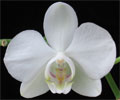|
|
|
|
 |
Email Address Recovery or Password Reset |
Use our Change Password page, and you can set a new password, or if you don't remember which email address you
registered with, the same page may be able to suggest it based on another you enter.
|
|
|
|
|
| |
Flasks of
Phalaenopsis amabilis 'Olympic Beauty' × self |
|
| |
|
|
| |
| Number: |
TN6076 |
| Name: |
Phalaenopsis amabilis 'Olympic Beauty' × self
|
| |
Flasks are planted more sparsely than usual because the plants spread horizontally and would crowd each other too much.
|
| Type: |
self (What's that?) |
|
Seed Donor: |
Ellen Covey, Olympic Orchids
(Email: olympicorchids@gmail.com)
Donor's home page: https://olympicorchids.com
|
|
Click to Enlarge

Pod Parent Flower |
|
|
|
| |
Culture Notes from Donor: Parent plant: Temperature range I (60-83°F)
Comments: Parent plant: Vigorous plant produces multiple very long spikes. Flowers are white with light greenish tinge and have excellent shape and substance. Medium-sized plant.
For additional origin/habitat information supplied courtesy of
Charles and Margaret Baker, see further below, near the bottom of this page.
|
Temperatures we attempt to use in the lab & greenhouse:
| For Species: |
|
Spring, Summer, Autumn, Winter: days average 82°F, nights 61°F; best fit is Intermediate 83-60°F
(Source:
Baker's Web OSC) |
| For Genus: |
|
Spring, Summer, Autumn, Winter: days average 87°F, nights 64°F; best fit is Warm-Intermediate 87-64°F
(
) |
|
About the name...
| Etymology of |
amabilis |
|
From Latin "amabilis" lovely, enchanting.
(Source:
Mayr & Schmucker 1998) |
| Etymology of |
Phalaenopsis |
|
From Greek, "phalaina" moth; "-opsis" appearance.
(Source:
Pridgeon 1992) |
| Pronunciation of |
amabilis |
|
a-MAH-bi-lis
(Source:
Hawkes 1978) |
| Pronunciation of |
Phalaenopsis |
|
fail-eh-NOP-sis
(Source:
Pridgeon 1992) |
| Pronunciation of |
Phalaenopsis |
|
fal-eye-NOP-sis
(Source:
Hawkes 1978) |
|
If you would like to direct someone to this web page, please copy and paste this URL into your email:
http://troymeyers.com/d?016076
| Flask Information |
| Availability: |
We have sold all of the flasks for this item. |
| You should: |
Consider getting individual plants or compots instead of a flask.
You can place a "Notify Flask Recipients" Request, and either we or a flask recipient may contact you when plants are available.
You may also place a "Notify Retries" Request, and if an identical pollination (the same parents) is done again, we'll let you know.
You may reserve a flask, but it's very unlikely you'll get one ...this could only happen if we found a flask that we didn't know we had. |
| Yield Estimate: |
861 plants (based on flask surveys done 11/29/2007 through 09/03/2009)
|
| Plantlet Sizes: |
From many flasks 20 - 80 mm plants (based on flask surveys done 03/05/2008 through 02/16/2010)
From one most recently surveyed flask 30 - 45 mm (02/16/2010)
|
|
You might also want to:
|
View the seed assay for this item.
View items of the same species.
View items of the same genus.
|
| Ordering Information |
| You are not currently logged in. |
|
You must be a registered user and be logged in to reserve a flask or place a notification request. Please log in:
|
|
 |
Email Address Recovery or Password Reset |
Use our Change Password page, and you can set a new password, or if you don't remember which email address you
registered with, the same page may be able to suggest it based on another you enter.
|
|
|
|
|
|
|
|
| |
The origin/habitat information below is supplied courtesy of Charles and Margaret Baker
The following information is based on the name of the plant provided by the donor, and assumes that the name is correct. If the plant has been misidentified, then the following information may not be correct.
This text is copyrighted by the Bakers and may not be reproduced without permission.
ORIGIN/HABITAT: ORIGIN/HABITAT: Widespread from Malaya through Sumatra,
Java, and the rest of Indonesia. Distribution extends to Borneo, the
Philippines, New Guinea, and Australia. In Java, plants were once common
in the southern half of West and Central Java, especially near the coast,
but populations are now greatly diminished. Plants have been found in East
Java growing between sea level and 2000 ft. (610 m). Plants may still be
found in small, isolated pockets near the West Java/Central Java border
where they grow on trees overhanging the sea. In this extended range,
plants may grow high in tall trees in dense forests or on tree branches
sometimes so close to the ocean that the plants are washed by salt spray.
In Borneo, plants are found in Sabah on Mt. Kinabalu, and in Kalimantan
and Sarawak at undisclosed locations. Plants grow in lower mountain
forests from near sea level to about 4900 ft. (1500 m) and seem to grow
mostly in regions that experience a distinct but short dry season. in the
Philippines, plants are found in the southern islands of Balabac,
Bancalan, Lambugan, Palawan and Sulu and Tawitawi in the Sulu Archipelago.
In this region, plants are found at elevations up to 1650 ft. (500 m).
More about this information and the Bakers...
|
|
|
| |
|
|
|